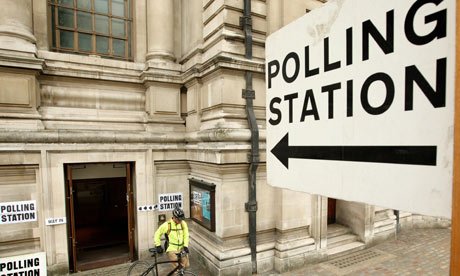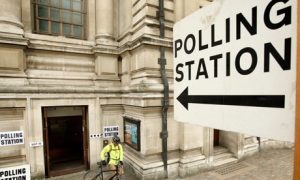One of the agreements reached in negotiating the terms of a Conservative/Liberal Democrat coalition government in Britain as a result of the May election was to hold a referendum next year on a new electoral system. Liberal Democrats demanded this concession because they are at a serious disadvantage under the current voting method. The relevant passage from the written agreement is as follows:
The parties will bring forward a Referendum Bill on electoral reform, which includes provision for the introduction of the Alternative Vote in the event of a positive result of the referendum…. Both parties will whip their Parliamentary Parties in both Houses to support a simple majority referendum on the Alternative Vote, without prejudice to the positions parties will take during such a referendum.
This statement contains two major components. The first is the substance of the referendum – the Alternative Vote. The second is procedural; it includes the parliamentary process associated with authorizing the referendum and the actions of the two parties in the campaign on the referendum itself. This article describes the system used in the most recent election, explains the Alternative Vote, and offers another possibility. It then goes on to discuss the role of the parties in Parliament and in the subsequent campaign on the proposed electoral change. Before analyzing the two parts of this statement a comment on terminology is necessary.
Election mechanisms are complex and come with endless variations. Terminology is a particular problem in that the same process may be known by several different names and the acronyms can be confusing. Given that this article examines the situation in the United Kingdom, I will use the British terminology as reflected by the Elector Reform Society, a link to which can be found at the end of this discussion. I recommend that site for further details on the three systems to discussed here and for information on other election procedures.
Britain currently uses the First Past the Post (FPP) method for elections to the House of Commons. The country is divided in 650 constituencies (or districts) with one member to be elected from each. Voters cast one vote in their constituency and the candidate with a plurality, one vote more than any other single candidate, wins the seat. A major advantage of this process is its simplicity – something to be considered in advocating any alternative. Its weakness is that it works against smaller parties, the Liberal Democrats, and in favor of the larger groups, the Conservative and the Labor parties. It also has the effect of encouraging a two party system. The results of this year’s election dramatically illustrate these points; the results were as follows:
Conservatives: 36% of the popular vote; 47% of the seats
Labor: 29% of the popular vote; 40% of the seats
Liberal Democrats: 23% of the popular vote; 9% of the seats
The issue for the Liberal Democrats is immediately clear; the party claimed less than half the seats it would have won if the outcome had been based on the total national party vote. The problem that the smaller party faces is that its support is broad but shallow. Broad support means that a party receives a significant percentage of the vote nation-wide. Shallow indicates that its voters are not sufficiently concentrated geographically so as to win many seats at the constituency level. Thus the Liberal Democrats want a change.
The Liberal Democrats advocate replacing the FPP with the Alternative Vote (AV), the principle features of which are that the voter ranks the candidates in order of preference and the requirement that a majority, rather than a plurality, be achieved to win the seat. If a candidate wins a majority of first place votes, he or she is elected. In the event that no one receives a majority, the second preferences of the candidate who came in last are redistributed to the other candidates until one of them reaches the required majority. The system ensures that not one will enter the House of Commons with less than majority support in a constituency and its advocates maintain that smaller parties will be represented more in proportion to their popular support.
Not everyone agrees with the latter point; some experts argue that the Liberal Democrats would have increased their representation had the AV been in place in the last election – but not by very much. I see two additional problems with the Alternative Vote: its complexity and the fact that it does not take into account two issues of concern to many voters.
Its complexity has two dimensions. First, many voters may find it difficult to rank the candidates. Though ranking would not necessarily be required, the system is predicated on voters doing that. I have voted in more than 40 congressional and state legislative. My frequent problem was in finding one candidate to vote for; I would have had great difficulty in ranking all the candidates. The second complexity issue involves counting the votes – that is reassigning the votes of the last place candidate. I have a strong personal dislike of any system which relies too heavily on election officials and machinery, especially since the U.S. presidential election of 2000.
Most people approach an election with two questions in mind – which candidate does the voter want to see win and which party does that voter want to have control of parliament so as to form a government? The Alternative Vote does not adequately take into account either candidate orientation or party orientation. These two perspectives can be understood best in the context of the Additional Member System which I suggest is a better option than the Alternative Vote.
The Additional Member System (AMS) is employed in a number of countries and I believe it to be better for Britain. In this system the voter casts two votes – one for a candidate to represent a constituency and one for a party. Under this possibility the House of Commons would consist of 450 members elected through the existing first past the post process. Instead of 650 constituencies, there would be a smaller number, 450, of larger constituencies. These seats would continue to be filled by the candidate who won a plurality, one vote more than any other single candidate.
The second part of the proposal is to fill the remaining 200 seats through proportional representation (PR). Proportional representation comes in a bewildering variety of permutations. I suggest the simplest – the single national list system. In that format all parties nominate a list of up to 200 candidates and rank them from 1 to 200 in terms of the party’s desire to see them take seats in Parliament.
Voters make two decisions in the election and vote twice. First they vote for one candidate to represent the geographical area – constituency – in which the voter resides as they do now. Second, they vote for one of the several single national party lists. Every voter would make a choice among the same lists nationally. The 200 seats to be decided in this part of the election would be assigned to parties based on their proportion of this second vote. For example, if a small party were to receive 10% of the vote for its national list, then the top 30 (10%) on that list win seats.
A change along these lines has several advantages. Most importantly AMS allows voters to take into account their candidate and their party interests. Let me illustrate with an example. I am a British voter whose best friend is running for the House of Commons from my constituency. Although he is a well qualified candidate whom I think would do a good job, there is a problem: I do not like the party that he represents and I do not want that party to control the national legislature. I am, like so many voters, cross pressured or conflicted. If AMS were in operation I could address both of my interests by voting for my friend in the constituency part of the ballot and for my preferred party in the party list contest. This strategy may not be entirely consistent, but many voters have conflicting loyalties which are difficult to balance.








Thank you for initiating this discussion!
The Liberal Democrats do not advocate replacing the FPP with the Alternative Vote. A referendum on AV was simply the best concession they could wring out of the Conservatives at this time.
The Lib Dems advocate using the Single Transferable Vote, a proportional system that uses a preferential ballot like AV, but in multi-member constituencies. They hope that AV will be a stepping stone to a fully proportional system.
AV is not a proportional voting system, and it remains to be seen whether it will help the Lib Dems. As can be seen in Australia and Nauru, the only places to use this voting system to elect their national legislatures, It tends to stifle diversity even more than FPP.
The Lib Dems also obtained a commitment to a House of Lords fully elected through a proportional system. This may turn out to be their most important achievement.
As for a single national party list, it works well enough in Israel and Holland, two places that are small and relatively coherent, at least geographically, but most countries, especially federations, use regional lists. It would never fly in the UK, a place with strong and fiercely independent regional identities.